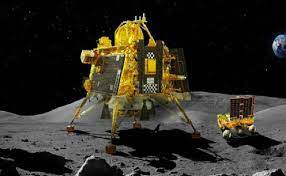As the clock struck 2.35 p.m.(14th July 2023), the finest of Indian scientists associated with the Chandrayaan 3 mission looked on with bated breath, holding on to their emotions, as Chandrayaan 3 was successfully launched and propelled into space by a 640-tonne, 43.5-meter tall Launch Vehicle Mark 3 (LVM3) rocket and on 23 August there was a euphoric celebration at the ISRO, Telemetry, Tracking and command network ( ISTRAC) Bengaluru because Chandrayaan 3 lunar mission of India become the first ever in the world to land near the Mutus crater in the south polar region (300 km. from the south pole at 70 degrees latitude), which is also the dark side of the Moon. None of the previous missions by other countries landed in this region.
The Indian space journey began when the Indian Academy of Sciences and the Astronautical Society of India advocated for a scientific mission to the moon in 1999, leading to the establishment of the National Lunar Mission Task Force by the Indian Space Research Organization (ISRO) in 2000. Expertise and technical capabilities were assessed, paving the way for the approval of an Indian probe to the Moon by the government in November 2003 and thus began India’s scientific romance with the moon marking a significant milestone in India’s space program
The scientific space love story between the space scientists and moon began in 2009 during Chandraayan 1 and Chandrayaan 1 managed to find water in the form of vapour in trace amount and also discovered water ice in the north polar region of the moon ,it confirmed Ocean Magma Hypothesis and detected X-ray signals during weak solar flares thus indicating presence of Mg, Al, Si and calcium on lunar surface and also detected new spinel rich rocks after that Chandrayaan 2 mission was launched in 2019 but this mission had partially failed after its lander and rover could not execute a soft landing on the moon and lander got crashed , but this failure didn’t break the confidence of scientists and scientists learnt from their mistakes and prepared for Chandrayaan 3 mission and chose failure based model ( every mistakes were deeply analysed and corrected) and Chandrayaan 3 mission was launched on 14th July 2023 successfully and on 23 august 2023 (06:04 pm)India created history and our Pragyaan rover and Vikarm lander touched the south region of moon (soft landing ) and this point is declared as Shiv Shakti point by Honorable Prime Minister of India. Every step from launching to testing was meticulously tested by ISRO scientists. The budget of Chandrayaan 3 was only Rs.600 crores and the brilliance of the scientists filled the resource gap.
Process of soft landing
The launcher was LVM3-M4, height of 43.5 meters, a lift-off mass of 642 tons, two strap-on motors, a payload fairing, and two stages. The two stages are L110 and C25. The L110 stage carried liquid fuel, and the C25 stage carried cryogenic fuel. The strap-on motors carried solid fuel, and are solid rocket boosters. The lander, rover, and propulsion module known as the integrated module carried by GSLV MK3 and placed the integrated module in an Elliptic parking orbit (EPO) then the lander was carried by the propulsion module from the launch vehicle injection till the final lunar 100 km circular polar orbit and the lander did soft landing and rover deployed on the lunar surface to conduct in-situ scientific experiments.
Lander, rover, and propulsion module
Three modules which is known as integrated module are:-
- Lander(VIKRAM ) module ( it has 4 throttle-able engines equipped with Laser Doppler velocimeter LDV which will help to measure the speed of the lander and rover)
- Propulsion module ( Mass- 2148 kg)
- Rover (PRAGYAN)
Chandrayaan-3 carries a suite of scientific payloads to conduct in-situ experiments and gather data on various lunar phenomena. These experiments will provide valuable insights into the moon’s composition, geology, and environment.
1) Payloads of Lander –
a) Rambha LP (Langmuir probe) – it will measure the near-surface plasma (4th state of matter) density and its changes with time.
- CHASTE (Chandra’s surface thermo-physical experiment) – It will measure the thermal conductivity and temperature of the lunar surface.
- ILSA ( Instrument for lunar seismic activity)- It will measure the seismicity of the lunar surface and will help to understand the moonquakes
2) Payloads of propulsion module
- SHAPE (Spectro-polarimetry of habitable planet Earth) – The function of SHAPE is to study the spectral and polarimetric measurements of Earth from lunar orbit. This means that SHAPE will analyze the spectro-polarimetric signatures of Earth and will study spectral emission coming from Earth.
3) Rover payloads–
Rover is diminutive yet important it is deployed on the lunar surface to conduct in-situ experiments of the lunar surface its mass is 26 kg and speed is 1cm/sec and it has six wheels and its life cycle is 1 lunar day (14 earth days), power is 50 watt, no. of payloads is two.
By roving across the landing site, the rover will enable extensive scientific analysis and mapping, providing valuable data on the moon’s topography, surface features, and potential resources. This will pave the way for future missions that involve surface mobility and resource utilization.
- APXS (Alpha particle X-ray spectrometer) – This will help to determine the elemental composition of the lunar soil and rocks around the landing site. The elements to be studied include magnesium, aluminum, silicon, potassium, calcium, titanium, and iron.
- LIBS (Laser-induced breakdown spectroscope) – To determine the elemental composition of lunar soil and rocks around the lunar landing site.
Humanity’s fascination with the moon has persisted throughout the ages, beckoning us to uncover its hidden truths and unravel the mysteries of our universe. USA, Russia, and China took the lead by sending manned and unmanned spaceships to the moon and now India became the first country to land softly on the South Pole region of the moon.
The event is also a celebration time for the science fraternity around the world – as it is a collective endeavor that transcends borders, reminding us that the quest for knowledge is a universal endeavor, binding humanity together in its curiosity and ambition. The mission holds the promise of unveiling new lunar insights, inspiring future generations of scientists, and fostering international collaborations that will propel us further into the cosmos. The historic moment is also a matter of pride to millions of Indians around the world, and, a source of inspiration to the youth across the country dreaming to take up science as a career.
Soft landing on the south pole of the lunar surface was very challenging because of difficult terrain, lunar dust and speed, no atmosphere on the moon, and the far side of the moon that is dark side but scientist’s hard work and prayers of Indians made it possible.
Without space programs, we wouldn’t have GPS or accurate weather prediction. Such Space explorations are very important because they help to predict weather and it helps countries like India where agriculture is called a gamble of monsoon, many health problems are emerging these days and many precious elements from the lunar surface are to solve such problems.
Chandrayaan-3’s mission to the Moon signifies a significant milestone in space exploration. It promises to unlock valuable insights about the lunar environment, reshape our understanding of the moon, and inspire future generations to pursue scientific endeavors. With its advanced technology, ambitious objectives, and international collaborations, Chandrayaan-3 is poised to make ground-breaking discoveries and propel us further into the realm of space exploration. This mission demonstrated India’s technological prowess in space exploration and added to its reputation in the global space community.
One of the Project directors of Chandyaan 3 was Ritu Karidhal and she proved women are limitless India’s lunar mission created history also because there was the maximum number of women in the team and it motivated many girls to join STEM (science, technology, engineering, and mathematics). Today a girl is sitting in the remote village staring at the moon and dreaming of flying high just because of the unprecedented success of Chandrayaan 3. Along with discoveries of the solar system such space explorations are also empowering women.
Space X of USA is an example of an endeavor of private players and ISRO is also on the way to collaborate with the private players for this IN –SPACe (Indian National Space Promotion and Authorisation Center)launched on June 10, 2022, which opened the window for private players. We need innovative minds and these innovative minds are the need of the hour to combat many emerging problems like climate change, these innovative minds when not restricted will help to explore the universe. It’s time to join hands together to unravel the truth of the solar system and Earth and missions like Chandrayaan 3 paving the way for space exploration.
By: Ashish Rahangdale
Write and Win: Participate in Creative writing Contest & International Essay Contest and win fabulous prizes.
















